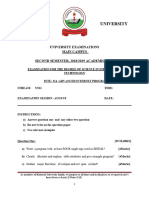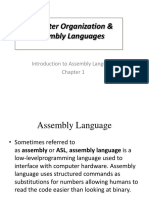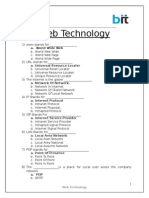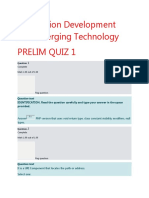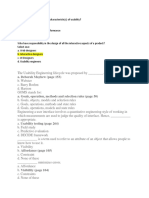0 ratings0% found this document useful (0 votes)
253 viewsInternet Programming II
This course is Internet Programming II, with the course code CoSc 322. It is a 3 credit hour course with 2 hours of lecture and 3 hours of lab per week. Prerequisites are CoSc 220 and CoSc 323. The course objectives are to develop an understanding of advanced web development, dynamic content, sessions, protocols, security and cryptography. Topics covered include advanced website development, dynamic content, sessions, protocols, PHP, connecting web pages to databases, XML, security and cryptography. Student performance will be evaluated through tests, lab exercises, assignments, a project, and a final exam.
Uploaded by
Rkf LanesraCopyright
© © All Rights Reserved
We take content rights seriously. If you suspect this is your content, claim it here.
Available Formats
Download as DOCX, PDF, TXT or read online on Scribd
0 ratings0% found this document useful (0 votes)
253 viewsInternet Programming II
This course is Internet Programming II, with the course code CoSc 322. It is a 3 credit hour course with 2 hours of lecture and 3 hours of lab per week. Prerequisites are CoSc 220 and CoSc 323. The course objectives are to develop an understanding of advanced web development, dynamic content, sessions, protocols, security and cryptography. Topics covered include advanced website development, dynamic content, sessions, protocols, PHP, connecting web pages to databases, XML, security and cryptography. Student performance will be evaluated through tests, lab exercises, assignments, a project, and a final exam.
Uploaded by
Rkf LanesraCopyright
© © All Rights Reserved
We take content rights seriously. If you suspect this is your content, claim it here.
Available Formats
Download as DOCX, PDF, TXT or read online on Scribd
You are on page 1/ 2
Course Title: Internet Programming II
Course Code: CoSc 322
Credit Hours: 3
Contact Hours: lecture 2hrs Lab: 3hrs
Prerequisites: CoSc 220, CoSc 323
Course Objectives:
This course is expected to achieve the following objectives:
Have a good understanding of advanced web site development; dynamic web
content creation; session tracking; Internet protocols; web security;
cryptography theory.
Enable students to specify, design, and implement a web site.
Course Description:
Introduces the student to web application development using an enterprise application
framework.
Topics include: -advanced web site development; dynamic web content creation;
session tracking; Internet protocols, ASP/PHP Web controls, connecting web page to
data base, loading and manipulating XML documents, web security; cryptography
theory; e-commerce programming
Course Content:
Introduction
Designing a good website
Types of web pages (static Vs. dynamic),
Web page design tools
Server-Side Scripting
PHP
Beginning with PHP
The PHP Language
Processing Web Forms
Object-Oriented Programming with PHP
Database processing using PHP
Advanced Markup languages
XML
WML
Web Security
Cryptography
Digital Signature
Method of Evaluation: Continuous Assessment:
Class Tests...................................................................... 20%
Lab Exercises............................................................... 15%
Assignments................................................................. 15%
Project............................................................................. 20%
Final exam ....................................................................... 30%
Teaching Methodology: The major techniques applied will be: Lecture supported
by Group discussions, Class work and Lab work, Demonstration, and Presentations.
Text Books:
Internet and World Wide Web How To Program, 5/E, (Harvey & Paul) Deitel,
Prentice
Hall, 2012
Reference Books:
Beginning PHP and MySQL 5: From Novice to Professional, Second Edition,
W. Jason Gilmore, 2006.
http://www.w3c.org - Specifications for web technologies such as HTTP, HTML,
DOM,
CSS, XML
You might also like
- Software Engineering B.Tech IT/II Sem-IINo ratings yetSoftware Engineering B.Tech IT/II Sem-II44 pages
- Introduction To Assembly Language Chapter 1No ratings yetIntroduction To Assembly Language Chapter 127 pages
- R.M.D. Engineering College Department of Computer Science and Engineering Cs8079 - Human Computer Interaction Unit Iv Mobile HciNo ratings yetR.M.D. Engineering College Department of Computer Science and Engineering Cs8079 - Human Computer Interaction Unit Iv Mobile Hci11 pages
- COSC 206 - Introduction To Human Computer Interaction.No ratings yetCOSC 206 - Introduction To Human Computer Interaction.347 pages
- Human Computer Interaction (COMS4041, COMS7054) Class Test: University of The Witwatersrand, JohannesburgNo ratings yetHuman Computer Interaction (COMS4041, COMS7054) Class Test: University of The Witwatersrand, Johannesburg2 pages
- JNTUA JNTUH JNTUK B Tech 2019 3 2 CSE Cyber SecurityNo ratings yetJNTUA JNTUH JNTUK B Tech 2019 3 2 CSE Cyber Security3 pages
- Application Development and Emerging Technology Prelim Quiz 1No ratings yetApplication Development and Emerging Technology Prelim Quiz 129 pages
- Computer Based Training & Distance Learning: University of Education, Vehari CampusNo ratings yetComputer Based Training & Distance Learning: University of Education, Vehari Campus29 pages
- Importance of Cyber Security IJERTCONV8IS05036No ratings yetImportance of Cyber Security IJERTCONV8IS050363 pages
- Department of Information Technology: Question Bank Department: IT Semester: II Class:-BE Subject:-Ubiquitous ComputingNo ratings yetDepartment of Information Technology: Question Bank Department: IT Semester: II Class:-BE Subject:-Ubiquitous Computing4 pages
- System and Network Administration MCQs - ITEC3123No ratings yetSystem and Network Administration MCQs - ITEC312324 pages
- Cse-CSEViii-web 2.0 & Rich Internet Application (06cs832) - NotesNo ratings yetCse-CSEViii-web 2.0 & Rich Internet Application (06cs832) - Notes86 pages
- Network Security and Cryptography Dr.P.rizwan AhmedNo ratings yetNetwork Security and Cryptography Dr.P.rizwan Ahmed6 pages
- Important Questions For System SoftwareNo ratings yetImportant Questions For System Software18 pages
- Wireless Communication and Mobile Computing100% (1)Wireless Communication and Mobile Computing2 pages
- Web System and Technologies II - Midterm ExamNo ratings yetWeb System and Technologies II - Midterm Exam2 pages
- Fill in TH Blanks - WebApp-XII-2022-Web Scripting - JavaScript-YKNo ratings yetFill in TH Blanks - WebApp-XII-2022-Web Scripting - JavaScript-YK7 pages




